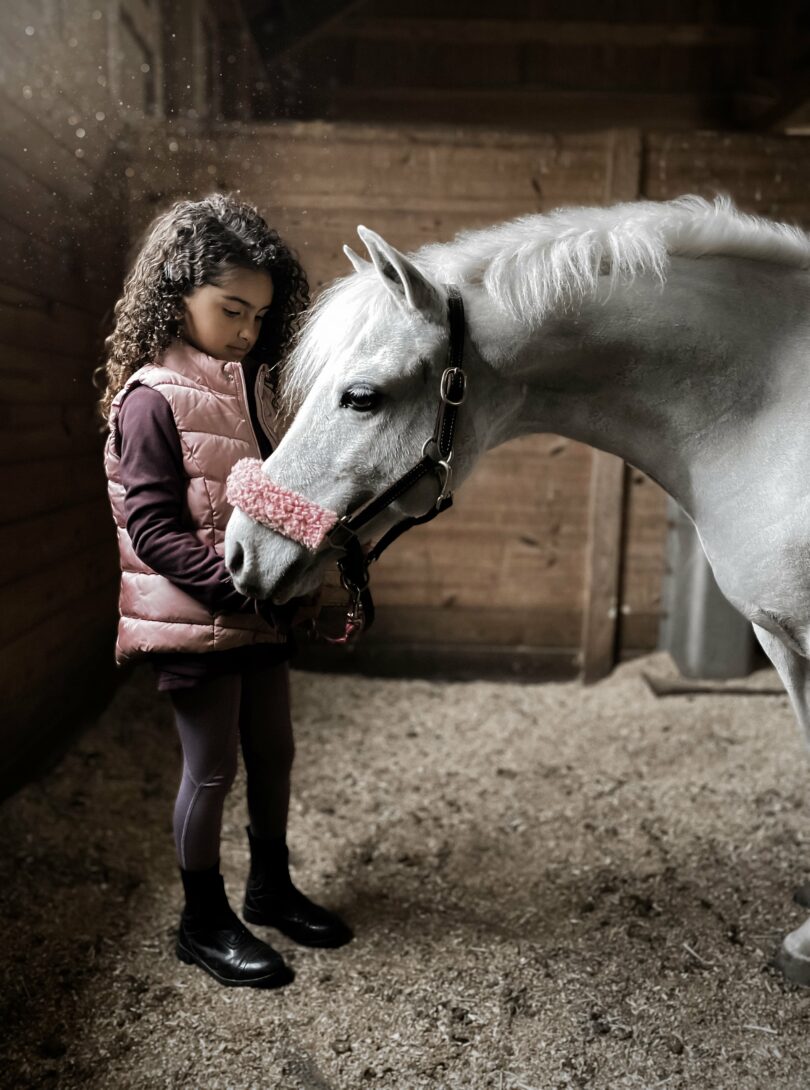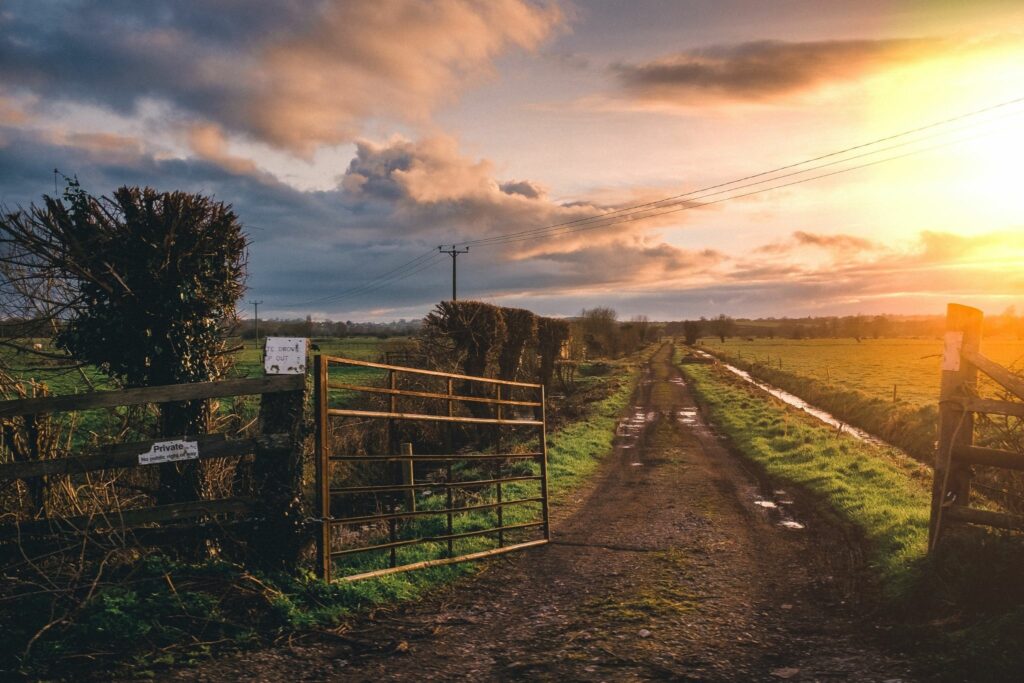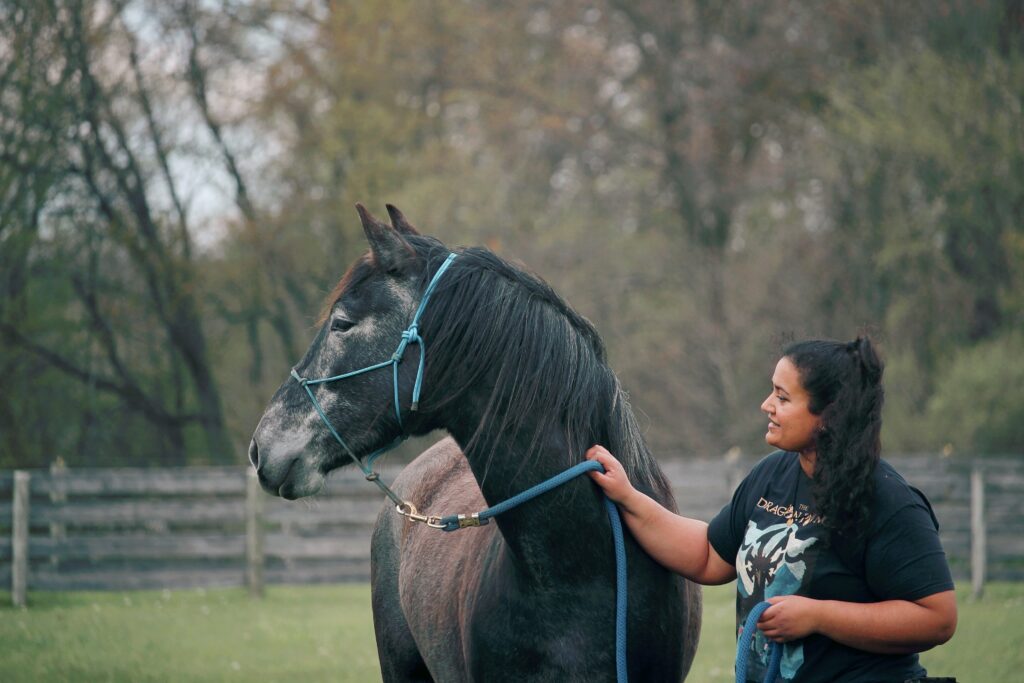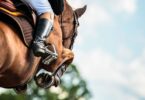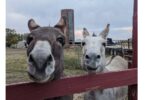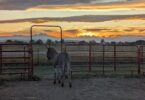Looking for pointers on how to handle a horse? Look no further!
Remember that even the most well-trained horse is still an animal and can be unpredictable. Unlike a car, or a bike, which does exactly what you ask, a horse is going to see and respond to stimuli by using its brain. It’s important to understand how that brain works so that we can anticipate responses and work together.
Learning to handle a horse safely is key to having fun around horses!
Feature photo credit: The Posh Equestrian
Safe horse handling starts with you. An understanding of how the equine brain functions, combined with following barn safety rules, will help keep you safe as you learn basic horse handling skills.

The Equine Brain & Body Language
Understanding how the equine brain processes and responds to information will help you better understand the “why” behind certain horse safety rules.
Horses are prey animals. They are herbivores and their best defense against danger is to run away. If running away isn’t an option, they may bite or kick to defend themselves. In order to be more aware of their surroundings, they live in groups, called herds, and are very attuned to what is going on around them. If one horse spooks due to a perceived threat, the others are likely to look around and possibly react to a threat as well.
Horses’ eyes are located on the sides of their heads, which gives them almost 360 degree vision. I say almost because they have a blind spot directly in front of them and directly behind them.
A common safety rule around horses is to never walk up directly behind a horse. This is because of that blind spot–if you startle the horse because he can’t see you approach, he may spook and react by running away or striking out behind him. It’s best to approach at the shoulder and use your voice to make sure the horse sees you.
Once you spend a little time around horses, you’ll learn to read their body language.
For example, you can tell a lot by a horse’s ears–if they are pricked forward, the horse is interested in something in front of it. One ear forward and one ear back means the horse’s attention is divided. If you’re riding and your horse’s ears are back, it is probably because they are listening to you.
The most important ear signal to be aware of is if the horse’s ears are pinned flat back–this means the horse feels threatened and may act aggressively.
Typical Barn Safety Rules
Different barns will have different safety rules, but this generic list will get you off to a good start:
- If you open a gate, you close the gate (Same goes for doors!)
- If you turn it on, turn it off.
- Do not approach animals you are unfamiliar with if you do not have permission
- Never feed an animal without permission – some horses bite, or have restricted diets
- Clean up after yourself and your horse
- Stay calm; do not make sudden movements (such as running) or loud noises
- No Smoking: Hay and sawdust can be flammable!
- No outside dogs allowed (not all dogs know how to behave around horses)
Basic Horse Handling Skills
Basic horse handling skills generally include everything—other than riding. Things like haltering, leading, and grooming fall under this category. Additional skills could include catching your horse from a pasture, longing, bathing, feeding, and loading into a trailer.
How to: Haltering
To halter a horse, start by making sure the halter and lead rope are ready by holding the halter by the crown piece and laying the lead rope over it in your right hand. Approach the horse at the shoulder, while making sure the horse both sees and hears you approaching. Put the lead rope around the horse’s neck to give you more control as you put the halter on.
Place the nose piece on the horse’s nose, moving it high enough on the nose that the crown piece will go behind the horse’s ears.
Buckle the halter tight enough so that it is secure on the horse’s face, but not too tight (you should be able to easily put a finger between the halter and the horse’s face). Take the lead rope off the horse’s neck, but make sure it is attached to the halter.
Now, you’re ready to lead the horse!
How To: Leading
When leading a horse, the horse should be on the handler’s right side (which means the handler should be on the horse’s left). Place your right hand on the lead rope approximately 6-12” from the snap. Fold the extra length of the lead rope into your left hand.
Make sure the extra length of the lead rope is folded and not looped in your hand.
If the horse spooks and the extra length is looped around your hand, you could get rope burn or the horse could drag you.
You should stand at approximately the horse’s throatlatch–always between their nose and shoulder. The horse should respect your personal space; some horses need to be taught this.
To walk, give a light tug forward on the lead rope and start walking. The horse should follow you. To stop, pull back on the lead rope and say “whoa.” To back, turn to face the horse, say “back,” and push the lead rope away from you.
To turn right, push the horse away from you and walk in an arc to the right. It is better to turn right than left. If you need to turn left, be aware of where you are in relation to the horse’s hooves so you don’t get stepped on. Pull the horse towards you and walk in an arc to the left.
How To: Grooming
To groom a horse, you’ll need it to be stationary. Tie the horse to a secure object, such as a hitching post, or put them in cross-ties. Always tie using a quick-release knot or use cross-ties with a quick-release snap.
Start grooming by using a curry comb.
This brush is usually made of soft rubber and can be used on the horse’s body–not on the legs or the face. Use it in a circular motion to bring dirt, hair, and dead skin to the surface of the coat where it can be brushed off.
Next, use a stiff (or hard-bristled) brush to remove the dirt/hair. The next brush to use is the hard-bristled brush. This will help remove the dirt/hair you loosened with the curry comb. Brush in the direction the hair grows.
Then use a soft brush, also called a finishing brush. This can be used all over the horse’s body, as well as on the face and legs. It removes smaller particles and can add a nice shine to the coat.
If you’re new, ask about brushing the horse’s tail. Personally, I never touch the tail under normal circumstances. The more you brush the tail, the more likely you are to pull out hairs, thinning it. I only brush the tail if I’m going to a horse show and have washed/conditioned it first.
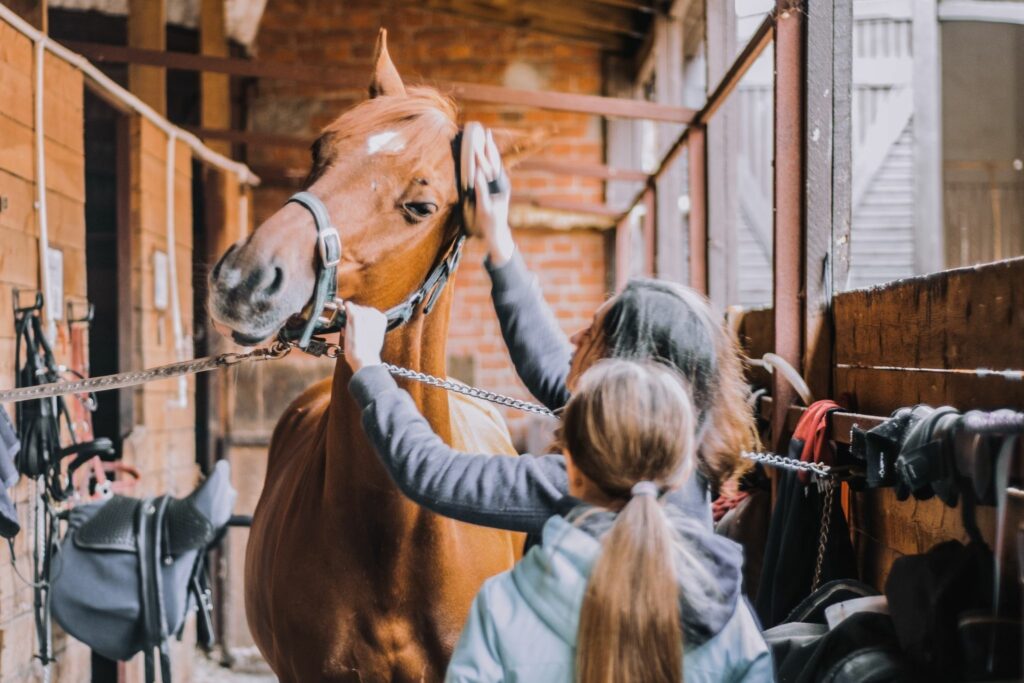
You can use a simple plastic comb in the mane, or a human brush. Start at the bottom and work your way up so you don’t rip out tangles.
Never, ever cut a horse’s forelock. Never cut a horse’s mane or tail without permission.
Last, you’ll want to pick up the horse’s feet and clean them using a hoof pick. This helps make sure there are no rocks stuck in the hoof that could cause a bruise or lameness. Stand to the side of the horse, facing the tail, and run your hand down its leg to pick up the foot. You will pick from the heel towards the toe of the horse.
Be careful with the frog when picking a horse’s feet. This area is soft and you do not want to damage it.
Tools for Learning
To start, learning basic principles either online or out of a book is helpful. Next, learn by watching. Ideally, you’ll want to observe a professional or experienced equestrian, but to be honest we can all learn by watching someone do things the wrong way as well!
Lastly, learn by doing. It takes hands-on practice to figure it out and cement the process into your brain. We definitely suggest under a trainer or experienced equestrian’s supervision so you can safely build confidence.
Best Book for someone new to horses:
First Horse: The Complete Guide for the First-Time Horse Owner by Devereux Smith.
This book is great for beginners. It discusses handling, caring for, and even purchasing a horse.
Our runner-up book option is How to Think Like a Horse by Cherry Hill.
 Best YouTube channel:
Best YouTube channel:
Equine Helper – They have videos on everything from how to properly lead a horse to how to post trot. They also have some relatable and funny videos on their page.
Frequently Asked Questions
Q: Where can I find a horse safety worksheet?
For a tacking-up safety checklist, check out this article from Pro Equine Groom.
For a trailer safety checklist, Horse & Rider has a great article.
Q: What should you NOT do around horses?
You should not yell or make fast, sporadic movements around horses. Don’t approach or stand directly behind or in front of a horse.
Q: What should I wear when working around horses?
You should wear sturdy shoes or boots with a heel, long pants, and clothes that aren’t overly baggy. Helmets are a must for in the saddle! Gloves may be helpful depending on the time of year and type of work you are doing.
Q: Where should you not touch a horse?
Some horses are sensitive to being touched on their bellies, near their rear-ends, or near their reproductive parts.
Parting Thoughts
Handling horses can be so much fun when done safely! Take the time to learn the basics, practice by doing, and learn to observe horse behavior.
P.S. Enjoy this article? Trot on over to:
- 9 Best Online Horse Training Courses for Goal-Getters
- 2 Simple Ways to Improve Your Horse Relationship Today
- 32 Things you can do today to calm your riding nerves forever
- Teach a Horse to Stop Grazing While Leading (Step by Step)
- How can I calm my nerves before horse riding?
- What are some ways to gain confidence riding horses

